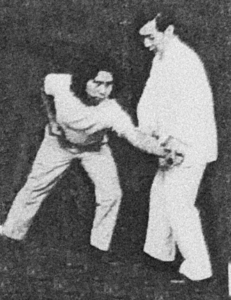Despite a few ancient crude wrestling and striking techniques, the majority of the martial art methods were brought to Japan primarily by the Chinese. Advanced “Kung Fu” methods over centuries were brought to Japan by Buddhist monks and others. In their systematization of combat weapons and arts, the Japanese borrowed greatly from China (1,p.83). … In China wrestling can be traced back to at least 700 B.C. During the Sui dynasty (A.D. 590-618) various holds and throws were used in contests (1,p. 47). In the Ming Dynasty (1368-1644) a faster, more scientific method evolved. It was during this time jacketed wrestling was exported to Japan.
Chinese wrestling was done by contestants wearing canvas shoes, trousers, and short sleeved jackets, held by a belt around the waist. Matches were three rounds of three minutes each, and three weight divisions: light, middle, and heavy. A throw or throws determined the winner. Only gripping of the opponent’s hands, arms, jacket, or belt was permitted (1,p.49).
Chin-na, originally called “muscle splitting”, “twisting skill”, and “devils hand”, is an integral part of most styles. Chin-na was exported to Japan near the end of the Ming dynasty and led to the development of jujitsu and judo (1,p.50).

In the 1700’s the Japanese invaded and took Okinawa, but the people continue to practice the Chinese arts (Okinawa Te), but without weapons which were prohibited. The te developed near Shuri was more external while that from Naha was internal. Naha te included grappling and throwing which were excluded from the other styles. Later the Okinawans used the name karate-jutsu which meant “China hand art” (1,p.59).
Master Okazaki studied a kind of “boxing” which he called mushi-jitsu. This he learned from a 78 year old Chinese man named Wo Chong, who was highly venerated by Master Okazaki (2,p.7). The intent of mushu-jitsu is to kill. However we are able to practice this slowly in combination with tui shau (“push hands”), and chi sau (“sticky/hidden hand”) from Tai Chi Ch’uan. It incorporates chin-na as well which can be added in san shou (“Tai Chi free fighting”). These techniques are reflected in the highest of our secret arts of Danzan Ryu. Master Okazaki was so indebted to Master Wo Chong that he named his style Dan Zan, the name the Chinese gave to the Hawaiian Islands.
Prof. Edwards
1. Comprehensive Asian Fighting Arts, Drager & Smith, 1969, Kodansha
2. The Science of Self Defense for Women & Girls, Okazaki, 1929, Nippu Jiji
